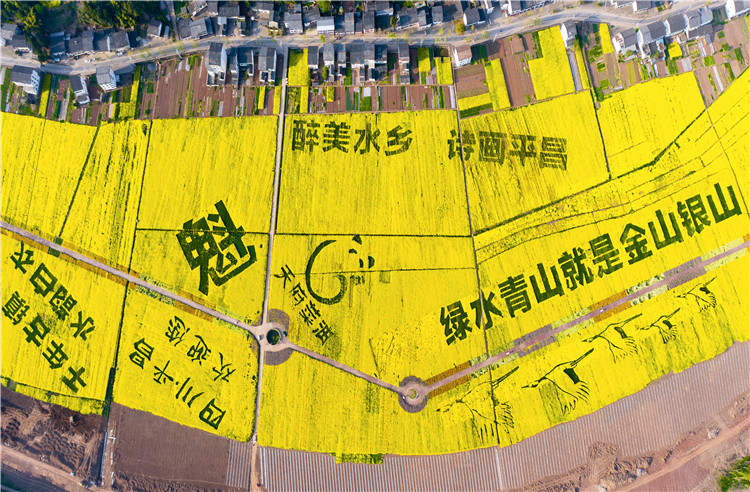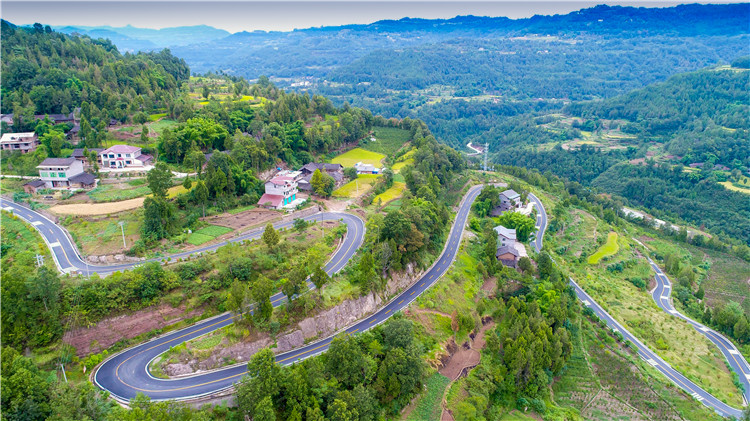[10 years on] Bazhong puts a new look on its transport development
Coordinated development in the building of main and secondary roads
Over the past decade, Bazhong has rolled out a large number of major transport projects to strengthen its internal and external accessibility and bring benefits to thousands of households.
The city has renovated and upgraded county-level and township-level roads stretching 1,346 kilometers, expanded the width of 1,491 kilometers of rural roads, built 7,000 kilometers of inter-village roads and 13,797 kilometers of intra-village roads, constructed nearly 200 bridges for vehicles and passengers, and won two national-level and five provincial-level honors for its transport construction, laying a solid foundation for the implementation of poverty reduction and rural revitalization schemes.
Incorporating transport building into the development of feature business

An industrial road in Baiyi town, Pingchang county [Photo provided to spotlightbazhong.com]
Over the past decade, Bazhong has always adhered to the principles of green and innovation-driven development, attached great importance to the integrated development of its transport and the development of industrial and tourism sectors, and achieved the coordinated and green development of its comprehensive transport network.
The city founded Bazhong Transport Investment Co., Ltd to address capital shortage in transport construction, adopted road chief systems to strengthen the maintenance and governance of roads, installed smart monitoring and commanding systems to follow traffic flows and respond to emergency conditions, and implemented strict safety production accountability mechanisms in a drive to prevent the occurrence of major traffic accidents.
The city has built five county-level logistics warehouse centers, established a set of industry-driven roads in Nanjiang and Bazhou to the benefit 672,000 people in 242 villages, opened several special tourism routes characterized with ecological strength, industrial development, historical and cultural deposits, constructed roads for residents in 1,497 mountainous villages, and taken transport construction as an important carrier to speed up rural revitalization, the rejuvenation of former revolutionary bases, and the modernization of agriculture and rural areas.
This year, the city has founded a center of low-carbon transport to promote the development of green transport, encouraged the use of green public transport, built 31 comprehensive charging stations and introduced 140 fuel-cell electric vehicles for public transport.
The prospect of transport development in Bazhong

Banqing road in Pingchang county, one of top ten most beautiful rural roads in China [Photo provided to spotlightbazhong.com]
Right now, Bazhong has been positioning itself to further enhance its strength in transport, become a key transport hub for both Sichuan and Chongqing in their northward development, integrate with the Chengdu-Chongqing economic circle, grow into a demonstration area for the coordinated development of Dazhou, Wanzhou and Kaizhou, endeavor to be a new western land-sea corridor, and set an example for other former revolutionary bases in transport development.
By 2025, Bazhong is set to become a leading city in transport in a national piloted initiative, accomplish the building of a modern comprehensive transport network, have 12 railways and expressways linking it with other places in Sichuan and the rest of the country, will have built a two-hour transport circle with Chengdu and Chongqing and a 1.5-hour transport circle with neighboring cities, and further enhance transport accessibility of all places, including scenic areas.
By 2035, Bazhong is poised to build into a leading domestic city in transport, conclude the construction of a modern comprehensive transport network that is secure, convenient, efficient, green and economical, become a key link for Chengdu and Chongqing in their northward development and a demonstration city on transport among all former revolutionary areas. It will boast nine railways and 13 expressways heading to other places in Sichuan and the country, connect all county-level areas with one railway and two expressways, create a three-hour transport circle with major domestic cities, a 1.5 hour transport circle with Chengdu, Chongqing and Xi'an, and a 1.5 hour transport circle with all townships, and initially modernize its transport governance system and capacity.

